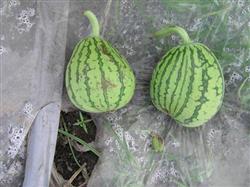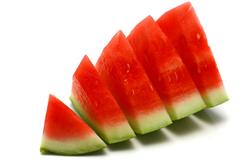Watermelon should pay attention to prevent the harm of new virus

A quarantine virus disease, cucumber green mottle mosaic virus, has been discovered. It is necessary to pay attention to prevention, but it is not necessary to pull it out and replant regardless of the reason. Here, let's introduce this new viral disease. Cucumber green mottle mosaic virus has a narrow host range, which mainly occurs in several cucurbitaceae crops, such as cucumber, watermelon, melon and so on. The virus belongs to mosaic virus, and its symptoms are similar to those of common mosaic virus (mainly tobacco mosaic virus and cucumber mosaic virus). The main symptoms are slow plant growth and development, irregular discoloration or yellowish mosaic, green protruding surface, uneven leaf surface, leaf edge curling, and then dark green concave spots, which are alleviated with the aging of leaves. The virus has a great influence on the fruit, such as yellowing or whitening of melon strips and dark green blister-like necrotic spots on cucumbers; the surface of watermelon fruit is uneven, the sound is blunt when slapping, the flesh is seriously discolored or deteriorated and rotten, and it is in the shape of towel gourd when ripe, commonly known as "blood flesh", which tastes bitter and can not be eaten. From the point of view of the route of transmission of the virus, it is mainly transmitted through seeds and contact (juice contact or agricultural operations), but it can also be transmitted through soil, but the virus has not been found to be transmitted by virus-borne pests. Therefore, in the early spring watermelon in the arch shed, most of the watermelons occurred in a large area before April, and vegetable farmers should pay special attention to the watermelon seedling stage and after planting. To prevent the virus, you must first disinfect the seeds. Soak the seeds with 10% trisodium phosphate solution for 10-20 minutes to avoid seed transmission. If suspected virus symptoms are found in the seedling stage, they should be removed immediately, the surrounding plants should be isolated and observed, and Ningnanmycin, virus A, chitin and other prevention should be sprayed. If the virus has occurred in a large area, it is necessary to change the stubble in time, and do not replant watermelons, cucumbers and other susceptible crops, but plant eggplant fruits and beans instead, so as to avoid the spread and occurrence of the virus.
- Prev

The reasons for the difficulty of setting fruit and many abnormal fruits of watermelon
In the process of watermelon production, due to the influence of adverse factors, it is often difficult to set melon and have many abnormal fruits, which reduces the yield and commerciality, and directly affects the income of growers. The reason why it is difficult for watermelon to set fruit is as follows: in the period of watermelon blossom and fruit setting, there are high temperature and high temperature in abnormal climatic conditions.
- Next

Cultivation and control techniques of main diseases and insect pests of watermelon
Once known as the "watermelon king", three groups of villagers in Yuwanggang Village, Qifang Town, Zaoyang City, Hubei Province, supported the army, and found out a good way to sweeten watermelon after years of practice, which is now for reference. First, watermelons sit for about a week, dig holes 10 centimeters away from the main root, apply 50 grams of cake fertilizer per plant, seal the soil and water. This method can make.
Related
- Moge, come on! The staff of the peasant association in the producing area of cantaloupe were frightened when the crowd gathered.
- Causes and Solutions of low Fruit setting rate of Apple
- Symptoms and control measures of passion fruit virus disease
- Fruit growing lesson: how do apple orchards keep high yields?
- Can you build orchards in the mountains? What are the pros and cons?
- How to manage the coloring period of Crisson grape?
- This paper introduces the processing technology of two kinds of fig products.
- How much is a month for retired teachers in rural areas by 2020?
- How can strawberry planting increase sugar content? We should pay attention to management in many aspects.
- What are the cultivation techniques on how to improve the yield of golden fruit?

